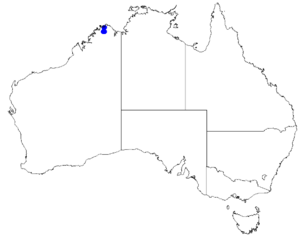Boronia kalumburuensis facts for kids
Quick facts for kids Boronia kalumburuensis |
|
|---|---|
| Conservation status | |
| Scientific classification | |
 |
|
| Occurrence data from Australasian Virtual Herbarium |
Boronia kalumburuensis is a special plant that belongs to the citrus family. This family includes plants like oranges and lemons! This particular plant is found only in the Kalumburu area of Western Australia. When a plant or animal is found only in one specific place, it's called endemic.
This plant is a shrub that can stand tall or spread out. It has many branches and its leaves look like feathers. Its flowers are usually white or pink and have four petals. The sepals, which are like small leaves that protect the petals, are longer and wider than the petals.
What Does It Look Like?
Boronia kalumburuensis is a shrub that can grow up to 50 centimeters (about 20 inches) tall. It has many branches that can stand upright or spread along the ground. If you look closely, you'll see that its branches and leaves are covered with tiny hairs that look like stars!
The leaves of this plant are quite interesting. They are made up of 15 to 27 smaller parts called leaflets. Each whole leaf can be between 8 and 40 millimeters (about 0.3 to 1.6 inches) long. The stem that holds the leaf is called a petiole, and it's usually very short, only 1 to 2 millimeters long.
The leaflet at the very end of the leaf is shaped like a spearhead. The leaflets on the sides are oval-shaped and are a bit shorter and narrower than the end one.
The flowers usually grow one by one where a leaf meets the stem. This spot is called a leaf axil. Each flower sits on a small stalk called a pedicel, which is about 7 to 24 millimeters long.
The four sepals are triangular or egg-shaped. They are about 3.5 to 6 millimeters long and have many hairs on their back. The four petals are about 2.5 to 4 millimeters long. Inside the flower, there are eight stamens, which are also hairy. You can usually see these flowers blooming from May to July.
How Was It Named?
The plant Boronia kalumburuensis was officially described for the first time in 1997. It was named by a scientist named Marco F. Duretto. He found a sample of the plant near the Kalumburu airstrip. The description was published in a science journal called Nuytsia.
The second part of its name, kalumburuensis, tells us where the plant was found. It refers to the Kalumburu community. The ending -ensis is a Latin suffix that means "from a place" or "belonging to a country." So, kalumburuensis means "from Kalumburu."
Where Does It Grow?
Boronia kalumburuensis grows in areas with sandstone and quartzite rocks. It is only found in the Kalumburu area. This area is located in the Kimberley region, which is in the far northern part of Western Australia.
Is It Protected?
The Western Australian Government's Department of Parks and Wildlife has given this boronia a special classification. It is listed as "Priority Three" flora.
What does "Priority Three" mean? It means that scientists don't know a lot about this plant yet. It's only found in a few places. However, it's not in immediate danger of disappearing. This classification helps make sure that the plant is watched over and protected.


